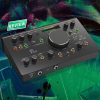
Review: Arturia Minifreak
A six-voice hybrid synth with a bunch of freaky aces up it sleeve.
‘What is it with these crazy frogs?’ It’s one of the first questions I asked myself after unboxing this synth. And no, I’m not making some non-PC reference to Arturia’s Gallic origins, I’m referring to the frogs on the UI. Three of them. Progressively pudgier.
The short answer is: the frogs designate the octave range of the arpeggiator. Why frogs? I don’t know and I don’t much care. But I like it.
What the frogs do tell me is this synth is designed for creativity and spontaneity, and doesn’t take itself too seriously. In fact, Arturia itself calls the Minifreak a ‘Spontaneous Algorithmic Synthesizer’, and fair enough, too. (‘Algorithmic’ refers to the synth’s two digital sound engines, which are coupled to an analogue filter section.)
FAMILY FREAKS
Minifreak presents as a member of the same freaky fraternity as Arturia’s hugely successful Microfreak. The UI, the sound engines, the filter (inspired by the gutsy 12dB/oct SEM filter) all bear the family resemblance… only the Minifreak has a little more of everything, it seems. The 37-note mini keybed replaces the steampunk PCB ‘keys’ of the Microfreak — which I consider a ‘difference’ rather than an ‘improvement’, as the PCB approach definitely scratches a different itch. The three FX engines are a big upgrade (Microfreak is FX-free). More control pots fill the extra real estate afforded by the width of the keybed. The oLED remains resolutely tiny. The mod matrix has been expanded and there are a full 16 buttons to manipulate your arpeggiator/sequence. So much is now within reach without any need for menu diving. There’s a Shift button but you’ll rarely need to resort to it. Some of the biggest differences are around the back. Minifreak’s I/O includes MIDI DIN sockets and L/R outs (just like the best of the Beatles, the Microfreak is mono).
The oLED display may be tiny but the natty graphics compensate. For example, the animated graphics denoting the oscillator types, and the three filling flasks of the oscillator modifiers and FX section are instantly recognisable when text and numbers might otherwise require some cross-eyed interrogation. The pots are very responsive, instantly corresponding to feedback on the oLED. The user interface is a delight.
MAKING PATCHES
Minifreak might initially present as a fun-loving, hit ’n’ giggle synth but there’s enough depth to keep programmers satisfied. That said, even the C++ synth nerds will enjoy just how straightforward Minifreak is. It invites interaction. If you don’t know much about the cycling envelope (Arturia’s way of having a dual-function extra envelope/LFO), that’s okay, the controls are in front of you and demand to be played with. Combine the knobs with the tiny but satisfying oLED display and there’s more than enough feedback. Of course, at this price you can’t expect touch-sensitive pots — not something I missed particularly, given how responsive the controls are.
To summarise: there’s enough pot-per-function knobbage to make methodical and forensic sound design possible, if that’s how you roll, and enough ‘what the heck does this do?’ buttons to make happy accidents occur more regularly than a ‘non spontaneous’ synth.
Sonically, MiniFreak is just as capable of extreme annihilation and as it is the sort of delicate filigree timbres that could bring a grown man to tears. The algorithms, filter, FX and modifiers provide that sort of variety. It’s impossible to say if the Minifreak has a sonic sweet spot because it’s so versatile.
NEED TO KNOW
Arturia Minifreak
Spontaneous Algorithmic Synthesizer

ARPING ON
One of the real Minifreak highlights is the arpeggiator/sequence section. There are the aforementioned frogs (which violently ‘explode’ at four octaves of range) but that’s only the beginning. There’s a good variety of basic arpeggiator ‘shapes’ which can be messed with thanks to a Random octave button, a momentary Ratchet button that temporarily sends the arp into double time, a Repeat button for temporarily sticking the arp in place and a Mutate button that permanently throws a spanner in your arp ‘works’ — if you don’t like the mutation then just hit it again for another option.
Playing with the arpeggiator or sequencer is at its most satisfying when you have your left hand on the touch strips at the end of the keybed. A wee bit irked by the lack of mod wheel? Don’t be, the touch strips are way more fun. The right hand touch strip can, of course, act as a conventional mod wheel and the strip next to it can be a pitch bend but that’s just the beginning. Above the strips you can select the Macros button or the Gate/Spice button to reassign them. Arturia has programmed the mod destinations of the touch strips for maximum fun and impact. But with so many parameters interacting with each other you’ll find yourself blissfully lost down many a sonic rabbit hole.
GET YOUR FREAK ON
I loved messing with the Minifreak and performing with it as a second/lead synth. I think it lends itself to that. You don’t want to tuck the MiniFreak at the back of a multi-tiered synth rack and address it remotely from your DAW, as you’ll be missing out on the special freaky sauce. Given its performance credentials, I do wish it had some instant-access performance preset shortcuts.
If I’m going to gripe, I was also a bit bemused by how many of the presets have a halo of noise. It’s not just an artefact of the ‘Noise’-y algorithms as far as I can tell. Patch 18 (Picky), for example, is a plucky lead sound combining an FM and a modelled sawtooth oscillator and I don’t know why it deserves a tail of audible noise.
Some purists might also point out that I’m being seduced by the smoke/mirrors of the three-engine effects engine rather than than the character of the sound sources. That could be said of any digital synth, but I’d suggest the filter has plenty of character and the other modifiers are very powerful sound sculptors. The effects are good and generous, and can provide some welcome fairy dust (or extreme annihilation) at times. I’d suggest the hybrid digital/analogue approach is super-solid but Minifreak is not attempting to compete against a six-voice fully-analogue performance synth.
I’d heartily recommend the Minifreak to all. It’s not intended to act as the beating heart of your hardware synth arsenal, but there’s enough to inspire veteran synth aficionados and the sort of variety that offers superior value for those looking to purchase their first hardware synth.
there’s enough pot-per-function knobbage to make methodical and forensic sound design possible and enough ‘what the heck does this do?’ buttons to make happy accidents occur more regularly


- 6-voice polyphonic hybrid synthesizer
- 37-note velocity-sensitive Slim-key keybed with aftertouch
- 2 sound Engines with 22 oscillator modes in total
- Engine 2 can be used to process Engine 1
- 1 envelope per voice
- 1 cycling envelope per voice
- 2 LFOs per voice
- Polyphonic analogue filters and VCAs
- 6-voice polyphonic, 12-voice paraphonic, unison, or mono configuration
- 3 digital FX slots in insert or send mode, with 10 FX to choose from
- User-customisable LFO curves
- Mod Matrix with 7 sources and 13 potential destinations
- 64-step sequencer (4 pages of 16 steps)
- 4 lanes of automated modulation
- Performance arpeggiator controls including Ratchet, Octave Randomise, and more
- MIDI in/out/thru
- USB connectivity
- Sustain, audio in, and clock in/out connectivity
- Balanced stereo outputs
- 256 factory presets
- 256 user preset slots for MiniFreak hardware
OSCILLATOR TYPES
Osc 1 & Osc 2 have 14 Types in common.

BasicWaves
This Type blends the characteristics of the two traditional analog synthesizer waveforms: the sawtooth wave and the square wave.

SuperWave
add thickness to a digitally-generated synth waveform is to make multiple copies of it and detune them against one another.

Harmo
The Harmonic Oscillator applies a form of additive synthesis, where an evolving sound is made up of multiple harmonics that get louder or softer over time

KarplusStr
Developed by Kevin Karplus and Alex Strong at Stanford University, the Karplus-Strong model loops a burst of noise through a filtered delay. This can create a realistic model of a plucked or bowed string or a struck drumhead.

VAnalog
VAnalog is a virtual analog waveform model. It simulates two analog waves – pulse and sawtooth – each with highly variable waveshape.

Waveshaper
A waveshaper alters the rise and fall time of a waveform’s cycle.A wavefolder, pioneered by Don Buchla in the 1970s, does what it sounds like: it takes the top and bottom of a waveform and folds it back on itself, rather than simply clipping it off.

Two Op. FM
The Two Op. FM Oscillator is a two-operator frequency modulation source.

Formant
The Formant Oscillator uses granular synthesis to manipulate sound through a pair of formant filters.

Chords
The Chords Oscillator turns every note into a chord. You can set up chord voicings with two, three, or more voices, and select pitch range and inversions as well.

Speech
The Speech Oscillator borrows from the technology of the Texas Instruments Speak & Spell, a toy from the 1970s that could talk intelligibly.

Modal
The Modal Oscillator offers a simple way to obtain beautifully clear and realistic percussion tones.

Noise
Provides a variety of noise types, including particle noise, made up of tiny fragments created by sampling noise and turning down the sample rate.

Bass
The BASS Oscillator models a pair of waves – a sine wave and a cosine wave put into a set of two modelled circuits: a balanced modulator for the sine wave, and a quadrature oscillator that mixes it with the modulated cosine wave.

SawX
sawtooth wave has its phase modulated with white noise that’s been reduced in sample rate, then thickened with a chorus.

Harm
The HARM Oscillator starts with a fundamental frequency and adds harmonics.

Audio In
Osc 1 can route any audio signal from the Audio In Jack into MiniFreak’s signal flow. This audio is digitalized, then processed by a wavefolder and a decimator, with digital noise added.

FM/RM
Osc 1 modulates (FM) a waveform generated by Osc 2 then Ring Modulation (RM) can be added.
OSC 2 AUDIO PROCESSOR TYPES
Osc 2 has six unique Types that are designed to process the sound of Osc 1 rather than create a sound of their own.

Multi Filter
The Minifreak’s analogue filter is a sounds great, but there are lots of other kinds of filtering, which Multi Filter provides.

Surgeon Filter
Sometimes you need a scalpel to cut out frequencies you don’t want, or boost others for dramatic effect.

Comb Filter
Produces a distinctive hollow tonality of a comb filter.

Phaser Filter
Runs an input signal through a series of all pass filters. These filters shift the phase and then combined with the original to create unevenly spaced notches.

Destroy
Destroys your incoming signal by subjecting it to three heavy-handed signal processes: a wavefolder, a decimator, and a bit crusher.


























I don’t have the hardware version but the VST is as equally impressive.
Re Your comment about non touch responsive knobs,
The response can e
Be switched to one of 3 modes, direct hooked or proportional.
Bit surprised you didn’t mention :
The VST that comes with it turns the mFreak into a perfect control surface while also giving you virtual clones of your hardware.
thanks Kirke.